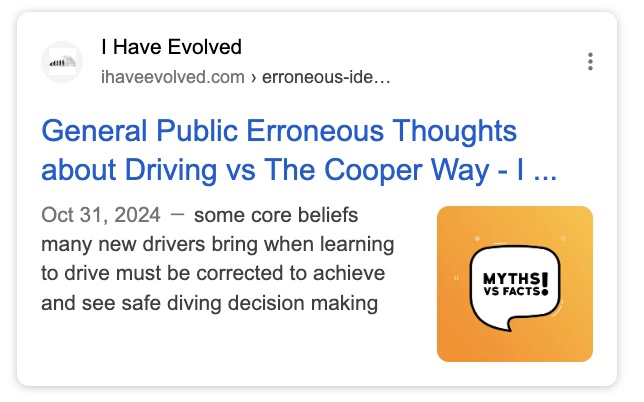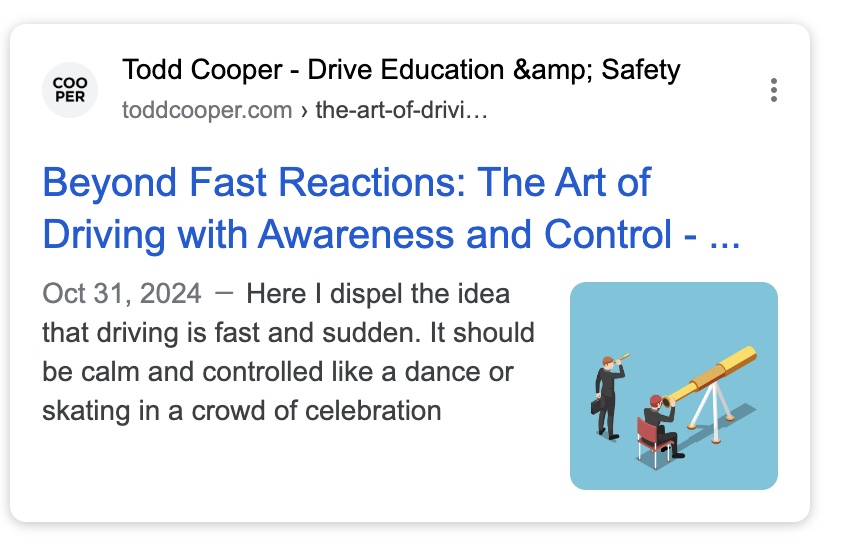Driving is something most people approach with the same set of beliefs passed down from others or reinforced by everyday experience. The prevailing ideas go like this:
- Danger happens suddenly and without warning.
- Safe driving requires fast reactions and quick reflexes.
- Caution equals slowness, which is dangerous or impractical.
- Using your horn is inherently “bad” or rude.
But I believe every one of these is a myth—a set of assumptions that actually holds us back from becoming truly skilled, aware drivers.
The one that stands out most to me is the idea of fast reactions. People think of driving as if they’re playing a video game: you see something last-second, your reflexes kick in, and you “win” by avoiding danger. But this approach misses an essential, fundamental truth: driving is about awareness, not reaction. Your eyes are your greatest tools, yet most people don’t use them as they could.
The Power of Seeing, Not Reacting
Think about it: we’re all sitting in our cars, often focused solely on what’s immediately ahead or directly around us. But our eyes can see far beyond that. Why limit yourself? Why not train yourself to see the environment in its entirety—what’s happening far down the road, to the sides, and behind you?
Imagine driving along a winding road in the evening. Many drivers would go along, prepared to react if something “suddenly” happens, like a car ahead swerving. But with the right level of awareness, you can spot that car behaviour early on and adapt well in advance, easing off the gas to give yourself more space and time. You’re not reacting in panic but responding smoothly and early.
This kind of driving isn’t about rushing or being tense, waiting for danger to strike. Instead, it’s about a calm, engaged approach where you’re constantly and increasingly, reading the road, observing what’s happening, and making adjustments that keep you out of the “fast-reaction zone.”
Why Settle for Being Average? Aim to Improve
Most people get their driver’s license and think that’s it—they’re done learning. But driving isn’t a skill that stays the same. Every time you get in the car, you have a chance to improve. Why not treat each drive as an opportunity to train your eyes, expand your awareness, and get better? If you’re going to spend decades driving, why not make it your goal to keep building on what you know?
Every drive can teach you something new about your environment, from understanding how different drivers behave to learning to read road patterns, weather changes, or potential hazards long before they reach you. Driving like this doesn’t make you a slower or overly cautious driver—it makes you one who is prepared and proactive.
Dispelling the Horn Myth
Another belief many people hold is that using the horn is somehow wrong or rude. But a well-timed tap on the horn can be a valuable signal that prevents potential issues. It’s not about blasting the horn out of anger but using it as a polite, preventative tool. The horn, like any other part of driving, is about communication, not aggression.
Driving can be so much more than simply getting from point A to point B. It can be a mindful practice where you learn to anticipate rather than react, to observe rather than wait for surprises, and to engage rather than just endure. This isn’t about being superior or criticizing others—it’s about sharing a perspective that could make every driver a little safer, a little more skilled, and a lot more in control.
Driving like this doesn’t make you a slower or overly cautious driver—it makes you one who is prepared and proactive.
What do you think I do every day in my car teaching from the passenger seat, calm and cool as a cucumber, driving anywhere the client wants to go, even when they are unable to handle the coming situation? The Answer Is – I USE MY EYES! Do you?
Learn to really really drive with Cooper. today.




Comments are closed